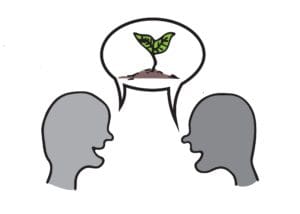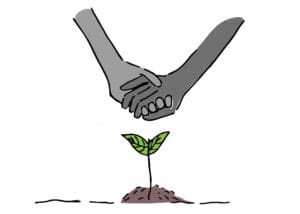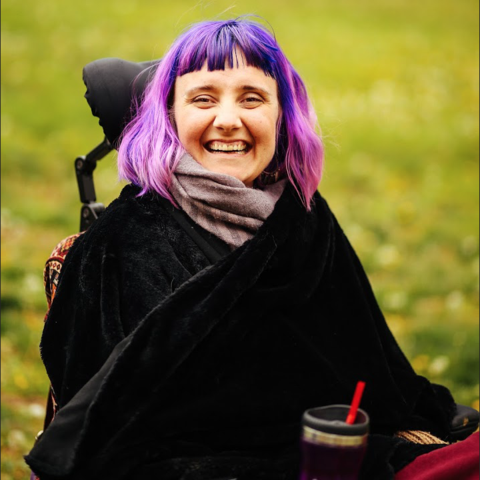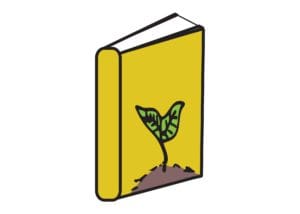Creating Anti-Ableist and Stigma-Free Classrooms
 শিখুন
শিখুন
The largest minority group in the U.S. is people with disabilities. Educate yourself on the ableist structures and common stigmas found within educational environments.
 চেষ্টা করুন
চেষ্টা করুন
If a student works with a 1:1 Paraprofessional and you’re giving an instruction to the student, make eye contact and directly speak to the student first, not assisting companions.
 চেষ্টা করুন
চেষ্টা করুন
Ask students with speech or hearing impairments for the modes of communication they are most comfortable with before beginning your lesson.
![]() মনে রাখবেন
মনে রাখবেন
Be intentional about introductions. How you introduce yourself and how you create opportunities for others to creatively introduce themselves and self-identify can set the tone for your time with students.
টিপ:
শুধু পরিচয়ের মতো, প্রতিবন্ধীতা সবসময় সহজে লক্ষ্য করা যায় না। যা দেখা যায় না তার প্রতি সচেতনতা, শ্রদ্ধা এবং সংবেদনশীলতা রাখুন।
The Impact of Ableism and Stigma Matter
Understanding ableism and stigma and its impact on individuals and classrooms empowers you to be a compassionate educator who preserves and protects the dignity and lived experience of students with disabilities. This awareness can also support you in advocating for the rights of disabled students in the school and beyond.
Ableism…
- isolates individuals;
- segregates learners;
- infects policymaking;
- emerges as structural and social discrimination.
আপনার ভাষার প্রতি মনোযোগী হোন

Image credit: Jean Wong
শব্দের শক্তি আছে। আপনি যে ভাষা ব্যবহার করেন তা নিজের বা অন্যদের সম্পর্কে একজন ব্যক্তির উপলব্ধির উপর প্রভাব ফেলতে পারে।
ভাষা মৌখিক এবং অমৌখিক। বডি ল্যাঙ্গুয়েজ এবং প্যারাল্যাঙ্গুয়েজ প্রায়শই আমরা শব্দ দিয়ে যা প্রকাশ করছি তার চেয়ে বেশি যোগাযোগ করে।
আপনার কণ্ঠের সুরটি শ্রোতার কাছে সমান গুরুত্বপূর্ণ যেমন আপনার লেখার সুরটি আপনার পাঠকের কাছে। আপনার সুর আপনাকে পর্যবেক্ষণকারী শিক্ষার্থীদের প্রতি আপনার মনোভাব এবং শ্রদ্ধা প্রকাশ করে। আপনার ডেলিভারি সম্পর্কে সচেতন হন।
আরো জানুন ইনক্লুসিভ ল্যাঙ্গুয়েজ গাইড দিন.
যেকোন মৌখিক ইনুয়েন্ডো সম্পর্কে সচেতন হোন
“As you talk about someone with a mental illness, you may pair certain words with a change in your tone of voice. For example, you may whisper the terms depression or bipolar. People pick up on these cues, which communicate depression stigma to the listener.”—Melissa Pinto, PhD, RN
ভূমিকা সম্পর্কে ইচ্ছাকৃত হন
আপনি কীভাবে নিজেকে পরিচয় করিয়ে দেন এবং কীভাবে আপনি অন্যদের জন্য নিজেকে পরিচয় করিয়ে দেওয়ার এবং আত্ম-পরিচয় দেওয়ার সুযোগ তৈরি করেন তা বিবেচনা করুন।
আপনি একজন প্রতিবন্ধী, অ-অক্ষম, বা অন্যথায় একজন ব্যক্তি হিসাবে চিহ্নিত করুন না কেন, আপনি ছাত্র বা স্কুল অংশীদারদের সাথে দেখা করার সময় আপনার পরিচিতির অংশ হিসাবে এটি অন্তর্ভুক্ত করার কথা বিবেচনা করুন, যেমনটি আপনার জন্য আরামদায়ক। শিক্ষার্থীদের জানাতে দিন যে আপনি ভুল করতে পারেন, আপনি তাদের সম্পর্কে জানতে চান এবং আপনার নিয়ন্ত্রণে যা আছে তার মধ্যে পরিবর্তন করার দায়িত্ব নেবেন।
যখন আপনি ছাত্রদের একটি নতুন দলের সাথে নিজেকে পরিচয় করিয়ে দেন:
- আপনি কোন পরিচয়গুলি শেয়ার করতে স্বাচ্ছন্দ্য বোধ করছেন এবং কোনটিকে অগ্রাধিকার দেবেন তা চয়ন করুন৷
- Consider how your introduction can open up communication and raise awareness about multiple identities and implicit bias. How can you normalize difference and destigmatize identities? What are the risks?
- যে প্রশ্নগুলো আসতে পারে তার জন্য সময় দিন এবং উত্তর দেওয়ার জন্য প্রস্তুত থাকুন।
শিক্ষার্থীদের নিজেদের পরিচয় দেওয়ার, স্পষ্টভাবে বলার এবং তারা কীভাবে আত্ম-পরিচয় করে তা শেয়ার করার জন্য একটি সুযোগের পরিকল্পনা করুন। আপনার পরিকল্পনার মধ্যে ফ্যাক্টর করুন আপনি কি করেন এবং কি জানেন না মানুষের গোষ্ঠী, শ্রেণীকক্ষের পরিবেশ এবং শিক্ষার্থীদের সাথে আপনার কতটা সময় আছে। ঝুঁকির কোন স্তর সঠিক বলে মনে হয়?
Here are some sample activity ideas.
- Freewriting: “What you need to know about me is…”
- This can be further worked on to become an artist statement, poem, or other creative piece.
- Drawing/Painting: Invite students to draw or paint who they are or what they look like.
- It could be a literal self-portrait or more of an abstract interpretation.
- "আমি এখান থেকে এসেছি..." বা অন্যান্য অনুরূপ প্রম্পটগুলি শৃঙ্খলা জুড়ে ব্যবহার করা যেতে পারে।
- Creative movement: Invite students to introduce themselves with a physical gesture.
- শিক্ষার্থীদের আমন্ত্রণ জানান তারা বেছে নিতে এবং শেয়ার করার জন্য একটি শিল্পী বা আর্টওয়ার্ক যার সাথে তারা চিহ্নিত করে এবং কেন।
- একটি শৈল্পিক অংশের জন্য অনুপ্রেরণা হিসাবে একটি পরিচয় বেছে নিতে ছাত্রদের আমন্ত্রণ জানান যা তারা পৃথকভাবে বা গোষ্ঠীতে তৈরি করবে, তাদের প্রত্যেকের জন্য কী গুরুত্বপূর্ণ তা উপস্থাপন করার উপায় খুঁজে বের করবে।
GIVE-এ আরও অন্বেষণ করুন অক্ষমতা এবং অন্যান্য পরিচয় সম্পদের ছেদ.
শ্রেণীকক্ষে একজন সচেতন যোগাযোগকারী হোন।
| করবেন | করবেন না |
|---|---|
| চোখের যোগাযোগ করুন এবং প্রথমে ছাত্রের সাথে সরাসরি কথা বলুন, সহচরকে সহায়তা না করে। | শিক্ষার্থীর সাথে যোগাযোগের অনুবাদের জন্য শ্রেণীকক্ষের শিক্ষক বা প্যারাপ্রফেশনালের উপর নির্ভর করুন। |
| বাক প্রতিবন্ধী শিক্ষার্থীদের সাথে যোগাযোগের পদ্ধতির জন্য জিজ্ঞাসা করুন যে তারা সবচেয়ে আরামদায়ক। | একজন শিক্ষার্থী মৌখিক বা শারীরিকভাবে কী প্রকাশ করার চেষ্টা করছে তা অনুমান করুন। পরিবর্তে, স্পষ্টীকরণের জন্য জিজ্ঞাসা করুন. |
| ছাত্রদের সম্প্রদায়ের অন্তর্ভুক্ত বোধ করতে সাহায্য করার জন্য তাদের সাথে সম্মানজনক কিন্তু সাধারণ ভাষা এবং সুর ব্যবহার করুন। | ধরে নিন যে আপনার কাছে স্পষ্ট ইঙ্গিত না থাকলে একজন শিক্ষার্থী প্রাথমিক নির্দেশাবলী বুঝতে পারে না। |
Plant Seeds of Confidence and Self-Esteem by Trusting That Students Are Able

Image credit: Jean Wong
Lead With Empathy
Try to set aside preconceived notions about your students and be open to newness and possibility. Developing a genuine appreciation for each unique student and their individual lives creates limitless opportunities for empathy.
শরীরের সাতটি অধিকার
These seven rights to the body are a consensus of shared values gathered from Eastern and Indigenous philosophy, religious beliefs, and human rights organizations. You can use these rights as a pedagogical guide to create a safe space for all learners and empower them to be advocates for themselves.
- উপস্থিত থাকার অধিকার—যেকোন স্থানে থাকা।
- The Right to Feel—to experience and express emotions.
- The Right to Act—to express yourself in your own way.
- The Right to Love and be Loved—to lead with your heart.
- The Right to Speak—to articulate yourself in a verbal or nonverbal way.
- The Right to See—to notice or sense your own way.
- The Right to Know—to understand.
প্রশ্ন আপনি কি সত্য হতে গ্রহণ করেছেন

Image credit: Jean Wong
“People may assume someone with depression or another mental illness is unstable, lazy, untrustworthy, unintelligent, or incapable, when that’s not the case.”—Mary Pender Greene, LCSW-R
আপনার অনুমান চেক করুন
একটি শ্রেণীকক্ষে প্রবেশ করা এবং শিক্ষার্থীদের আচরণে লেবেল বরাদ্দ করা সহজ। আগ্রহের অভাব বা সাধারণ অযোগ্যতার জন্য একটি শিশুর কর্মক্ষমতাকে ত্রুটিপূর্ণভাবে দায়ী করা আপনার নির্দেশনা এবং তাদের শেখার ক্ষমতার উপর আস্থা রাখতে বাধা হতে পারে। এটি শিক্ষার্থীদের সাথে ইতিবাচক সম্পর্ক গড়ে তোলার আপনার সুযোগকে অনিচ্ছাকৃতভাবে ক্ষতিগ্রস্থ করতে পারে। উপরন্তু, কালো, অ-শ্বেতাঙ্গ, এবং প্রতিবন্ধী মহিলা শিক্ষার্থীরা এই প্রতিবন্ধী শ্বেতাঙ্গ পুরুষ শিক্ষার্থীদের চেয়ে বেশি শাস্তিমূলক ব্যবস্থা গ্রহণ করে।
GIVE-এ আরও জানুন শিক্ষার্থীদের মধ্যে ইতিবাচক সম্পর্ক বিকাশের জন্য সংস্থান.
অস্পষ্টতা আলিঙ্গন
কোন বিষয়ে কর্তৃপক্ষ না হওয়া ঠিক আছে। শ্রেণীকক্ষে, ছাত্র-কেন্দ্রিক নকশা সহযোগিতামূলক কল্পনায় রয়েছে। যখন আমরা ফলাফল নিয়ন্ত্রণ করার প্রয়োজন প্রকাশ করি, তখন আমরা উদ্ভাবনের জন্য জায়গা তৈরি করি।
আত্ম-প্রতিফলনের জন্য সময় নিন
- How do I currently talk around and about people with visible and invisible disabilities?
- কোন ভাষা অনুশীলন এই সম্প্রদায়ের মর্যাদাপূর্ণ?
- কোন ভাষা অনুশীলন এই সম্প্রদায়ের রোগবিদ্যা?
- Have I depended on the Classroom Teacher or the Paraprofessional for translating communication with the student, or handling a student I don’t feel comfortable interacting with?
- একজন শিল্পী বা ব্যক্তি হিসাবে আমার জীবিত অভিজ্ঞতায় কীভাবে আমি আমার সাতটি অধিকার থেকে বঞ্চিত হয়েছি?
- আমি কিভাবে ছাত্রদের শ্রেণীকক্ষে তাদের অধিকার থেকে বঞ্চিত হতে দেখেছি?
- আমি কীভাবে ছাত্রদের সুবিধার্থে বা তাদের শৈল্পিকতায় তাদের শরীরের অধিকার অস্বীকার করেছি?
- আমরা শুরু করার সময় যদি আমরা উত্তর জানতাম, তাহলে আমরা সম্ভবত কী শিখতে পারতাম?
- আমরা কিভাবে সৃজনশীল সমাধান নিয়ে আসতে পারি?
- আমরা যাদের জন্য ডিজাইন করছি তারা কোথায় আমাদের গাইড করবে?
সকল শিক্ষার্থীর মধ্যে সমতা সৃষ্টি করুন

Image credit: Jean Wong
ছাত্রদের সম্পর্কে তৈরি অনুমান থেকে দূরে সামঞ্জস্য করুন
Take a moment to check or notice assumptions in the language used around or about your students, or in any actions taken, and make adjustments as necessary.
- Instead of: “He cannot sit still and pay attention long enough to do anything.”
- Try: “How can we make the activity more physically engaging for everyone?”
- Instead of: “She can’t read out loud. She’s too slow.”
- Try: “Let’s give her time and support while she reads.”
- পরিবর্তে: “I don’t think he can be the lead. The audience may get uncomfortable seeing him and hearing him like that.”
- Try: “Let’s give him the lead. If he feels like he needs a buddy to do parts of the scene, we can split the role.”
- Instead of: “You may not be able to do this activity; you can be our audience.”
- Try: “Would you like to try this activity? If so, we’ll support you.”
- Instead of: “I don’t know what is wrong with her. She is just so disruptive and shouldn’t participate.”
- Try: Avoid singling out students with these disabilities before entering the room. Design lesson plans that include moments for emotional literacy, journaling, and exploration as a first step. Introduce tools and spaces for self-regulation or support on the first day.
Work Toward Educational Equity
Our culture is filled with ableist representations and ideas that inform all of our lives. What assumptions do you make about
- what a student is capable of?
- how a student speaks or communicates?
- how a student uses their body?
- what a “good student” looks like?
- what it means or looks like to try or work hard?
- what it means or looks like to be actively listening?
- whether someone is the “right fit” for an activity or role?
- how a student might feel if they try something and fail?
- what an audience will expect a performer to look/sound like?
How can you use your content, language, and the art you share to move away from assumptions and toward educational equity for your students?
কলঙ্কের চারপাশে কথোপকথনে শিল্পীরা
মায়সুন জায়েদ, Comedian, Actress, Disability Advocate, and Tap Dancer
“‘I have cerebral palsy. I shake all the time,’ Maysoon Zayid announces at the beginning of this exhilarating, hilarious talk. (Really, it’s hilarious.) ‘I’m like Shakira meets Muhammad Ali.’ With grace and wit, the Arab-American comedian takes us on a whistle-stop tour of her adventures as an actress, stand-up comic, philanthropist, and advocate for the disabled.” This talk was presented at an official TED conference. TEDWomen 2013.
অ্যাডাম পিয়ারসন, Broadcast Journalist, Actor, Advocate, and Motivational Speaker
"অ্যাডাম তার বিকৃতির সাথে সংযুক্ত কলঙ্ক কাটিয়ে উঠার সময় জনসাধারণের চোখে নিজের জন্য একটি ক্যারিয়ার তৈরি করার সময় তিনি শিখেছেন এমন গুরুত্বপূর্ণ পাঠগুলি ভাগ করবেন।" এই আলোচনা একটি অফিসিয়াল TED সম্মেলনে উপস্থাপন করা হয়েছিল। TEDxBrighton 2017।
লিন্ডসে অ্যাব্রোমাইটিস-স্মিথ, Artist, Writer, and Healer
“I am most proud of the fact that I am still thriving despite my body becoming differently abled. I think my best work has come out of pushing against my limitations.”
লিন্ডসে অ্যাব্রোমাইটিস-স্মিথ তার পুরো জীবন ধরে শিল্প তৈরি করে চলেছেন। 2012 সালে ALS ধরা পড়ার আগে, লিন্ডসে একজন পুতুল শিল্পী, ভাস্কর এবং ম্যাসেজ থেরাপিস্ট হিসাবে কাজ করেছিলেন। যদিও তার আর তার বাহু এবং হাতের ব্যবহার নেই, সে আঁকার জন্য তার পা ব্যবহার করে সৃজনশীলভাবে নিজেকে প্রকাশ করে চলেছে।
“Living with ALS is the most difficult thing I have ever done. It has given me so many opportunities to slow down, figure out what is important to me, and shift my perspective on the world.”

GIVE রিসোর্সে প্রতিবন্ধী শিল্পীদের বৈশিষ্ট্য সম্পর্কে আরও জানুন: অন্তর্ভুক্তিমূলক পাঠ্যক্রম এবং প্রতিবন্ধী শিল্পীদের প্রদর্শন.


